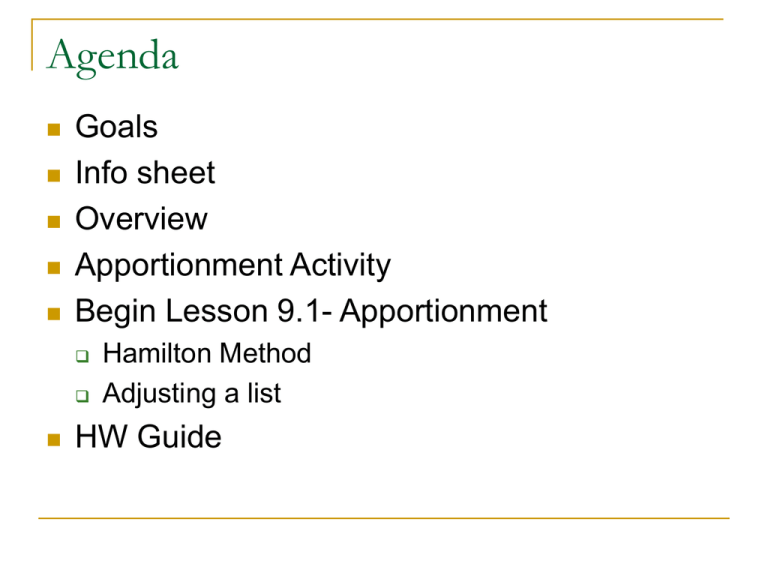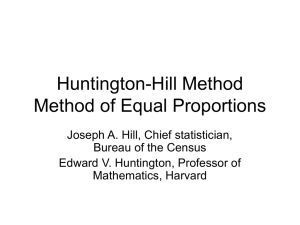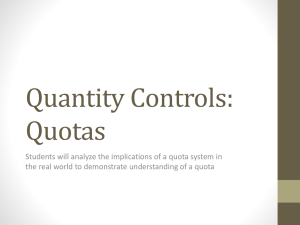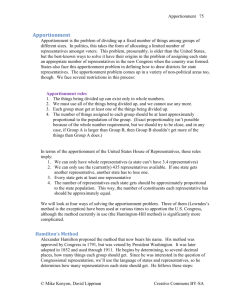Chapter 9 - Apportionment
advertisement

Agenda Goals Info sheet Overview Apportionment Activity Begin Lesson 9.1- Apportionment Hamilton Method Adjusting a list HW Guide Discrete vs. Continuous Data (Variables) Discrete Math is not easily defined. NCTM states DM is “the study of mathematical properties of sets and systems that have only a finite number of elements.” Discrete – values that can be counted Continuous – all values in an interval between two specific values, such as temperature. Statisticians gain information about situations by collecting data for random variables. Data Qualitative: categorical such as gender, religious preference, geographic locations Quantitative: Numerical and can be ordered or ranked, such as age, heights, weights, body temperature Discrete: (countable) such as Continuous: can assume Number of children in a family, students in a class, people in a state, or emails in a day all values in an interval, Temperature, time, distance, mass Mathematics All Around. Set and Number Theory Ch 1, 4 & 5 Graph Theory Ch 3 Thomas L. Pirnot Apportionment Ch 9 Voting Methods Ch 10 Discrete Math Modeling Ch 6 & 7 Descriptive Statistics Ch 14 Consumer Math Ch 11 Counting, Permutations, Combinations Ch 12 Portfolio Rubric Vocabulary Page Homework – Assignment # and date in top right corner. Due in pencil on due date; corrected in pen for final portfolio. News article / typed response Why did you choose the article? How does it relate to the unit of study What did you learn? Extra-credit topic (extension - not discussed in class) Portfolios should represent your own work and understanding; these are individualized for each learner. This allows us (student, teacher, parent) to see your strengths/weaknesses for assessment purposes. Late portfolios will be evaluated for half-credit. Chapter 9 - Apportionment • Vocabulary • Apportionment Methods – Hamilton – Huntington-Hill – Jefferson – Adams – Webster Hamilton Method of Apportionment •Gives each state integer part •Additional reps allocated by largest fractional part of exact representation Example 1- In a recent census… 1) Alabama – Population 4041 2) Mississiippi – Population 2573 3) Louisiana – Population 4220 Allocate 19 members of the U.S. House of Representatives to these three states. • 1st find the percentage for each state’s population to the total population State AL Miss LA Total % of Delegates Delegates deserved Integer Part Fractional Assign Part additional Members Your Turn 2) The Civics Arts Guild is having a show. There is room for 31 booths and the guild has decided that the booths will be assigned in proportion to the type of members in the guild. The guild has 87 painters, 46 sculptors, and 53 weavers. Assign the booths to the three groups. Group Painters Sculptors Weavers Total % of Booths Booths deserved Integer Fractional Assign Part Part additional Booths Adjusting a List by Truncating • Rank your biggest concerns about school. (1 representing your top concern) • Choose from the following: – Peer Pressure – My friends/social life – My grades – My safety State Peer Pressure My Friends/ Social Life My Grades Safety Total # ranked Original Truncated 1st % to tenths Discarded Portion Adjusted List Your Turn • #17 on page 518. Warm-Up 1. p.517 # 11 2. p.518 #17 Fairness of Apportionment • Average constituency = Population of state/ number of reps from state • Absolute unfairness= l(avg constituency of A) – (avg constituency of B)l • Relative Unfairness= absolute unfairness / smaller average constituency Example • Find the average constituency to determine which state is more poorly represented. State A has a population of 27,600 and 16 representatives and state B has a population of 23,100 and 14 representatives. • What is the absolute unfairness of this apportionment? • What is the relative unfairness? 27, 600 1, 725 • Average Constituency of A = 16 23,100 1, 650 • Average Constituency of B = 14 State A is more poorly represented. • The absolute unfairness is 1,725 – 1,650 = 75 75 0.045 • The relative unfairness = 1, 650 Your turn • # 26 on page 519 Warm-Up • Do # 29 on p. 519. Lesson 9.2 The Huntington- Hill Apportionment Principle – The student will use the Apportionment Criterion and the Huntington-Hill Apportionment Principle to determine the addition of representatives most fairly. Apportionment Criterion • When assigning a representative among several parties, make the assignment so as to give the smallest relative unfairness. • Example: Suppose that State A has a population of 13,680 and 5 representatives, and State B has a population of 6,180 and 2 representatives. Use the apportionment criterion to determine which state is more deserving of one additional representative. • If State A gets the rep then: A) Calculate the average constituencies for each. B) Calculate the relative unfairness for each. • If State B gets the rep then: – Repeat steps A and B • The smaller relative unfairness is the best Your Turn • #1 on p.524 Huntington-Hill Apportionment • Gives new rep preference by using the Huntington-Hill number. • H-Hill number (based on Geometric mean) 2 (population of Y ) (population of X ) ? y( y 1) x( x 1) 2 • The larger number indicates which state should receive the additional representative. Example • Iowa has a population of 2.8 million people and 6 representatives and Nebraska has a population of 1.6 million people and 3 representatives. Use the Huntington-Hill Principle to determine which state is more deserving of an additional rep. Iowa (2.8)2 7.84 0.186667 67 42 Nebraska 2 (1.6) 2.56 0.213333 3 4 12 Nebraska’s H-Hill number is larger so Nebraska deserves the additional rep. Your Turn • The Oil Consortium Board currently has 2 members from Naxxon, 2 from Aroco, and 1 from Eurobile. Use the Hamilton-Hill Apportionment Principle to decide which company should receive the next member on the board if Naxxon has 4,700 stockholders, Aroco has 3,700 and Eurobile has 1,600. • Naxxon should get the next rep. Warm-Up • Use the Huntington-Hill apportionment principle to decide which state is more deserving of an additional rep. – The population of Alaska, New Hampshire, and Wyoming are .6 million, 1.1 million and .5 million, respectively. Alaska has 1 rep, New Hampshire has 2, and Wyoming has 1. Lesson 9.3 • Applications of the Apportionment Principle. – The student will use the Huntington-Hill principle to apportion representatives or other objects in order. • Now we are going to determine how to apportion a given number of representatives and in what order they should be distributed. • Use the H-Hill method to apportion 10 reps among Utah, Idaho, and Oregon.The recent populations are Utah, 1.7 mil; Idaho, 1.0 mil; and Oregon, 2.8 mil. Begin by giving one rep to each state. List the order in which the reps are apportioned. Calculate the H-Hill #’s Current Representation Utah 1 2 3 4 5 6 7 Idaho Oregon Seat # 1 2 3 4 5 6 7 Goes to # of add’l reps Utah # of add’l reps Idaho # of add’l reps Oregon Your Turn • #9 p.533 Warm-Up We have 15 seats to apportion between the following groups: Freshmen with 420 students, Sophomores with 375 students, Juniors with 350 students and Seniors with 293 students. A) Use the Hamilton Method of apportionment to distribute the seats. B) Determine the relative unfairness between the freshmen and juniors. C) Which group is more poorly represented? Group % of Seats Seats Integer deserved Part Freshmen 29.2% 4.38 4 0.38 4 Sophomores 26.1% 3.915 3 0.915 4 Juniors 24.3% 3.645 3 0.645 4 Seniors 20.4% 3.06 3 0.06 3 Total 100% 15 13 Freshmen: AvgC= 105 Fractional Part Assign additional Seats 15 Juniors: AvgC = 87.5 The relative unfairness is 0.2. Which group is more poorly represented? Average Constituencies: • Freshmen – 105 • Sophomores – 93.75 • Juniors – 87.5 • Seniors – 97.7 The freshmen are more poorly represented. Lesson 9.4 Other Paradoxes & Apportionment Methods • The student will discuss other paradoxes and investigate and use other methods of apportionment to assign additional representatives/objects. Standard Divisor / Quota • Standard Divisor = Total population / number of reps being allocated Computed once (a single number) used for the entire apportionment process. The standard divisor is the # of constituents that each representative must represent. Standard Quota = State’s population / standard divisor Must be computed individually for each state/client. The standard quota is the # of representatives that a state deserves. Calculate the standard divisor and each state’s standard quota. • • • • We want to apportion 8 representatives among: State A with a population of 3 million. State B with a population of 4 million. State C with a population of 5 million. Total Pop 12, 000, 000 Standard divisor 1,500, 000 # of Reps 8 Standard Quotas: 5,000,000 4,000,000 3, 000, 000 3.33 2.67 C A 2 B 1,500,000 1,500,000 1,500, 000 • • • • Using Hamilton’s Method: State A would receive 2 reps. State B would receive 3 reps. State C would receive 3 reps. • Remember: Hamilton’s method uses the fractional parts to award additional reps. • Using the Hamilton method each state receives either the number immediately above or below the standard quota. Definitions • Lower quota – the standard quota rounded down. • Upper quota – the standard quota rounded up. • If in making an apportionment, each state is allocated a # of reps that is between its lower and upper quota, then we say the apportionment satisfies the quota rule. Restating Hamilton’s Apportionment Method • Compute the standard divisor. • Compute the standard quota for each state and round down to the lower quota. Assign reps. • Assign additional reps according to the fractional parts of the standard quotas. Other paradoxes • Population paradox – occurs when state A’s population is growing faster than state B’s population, yet A loses a representative to state B. • New-States paradox – occurs when a new state is added, and its share of seats is added to the legislature causing a change in the allocation of seats previously given to another state. Jefferson’s Apportionment Method • Compute the standard divisor. • Rather than computing the standard quota, compute a modified quota by using a divisor that is smaller than the standard divisor for the apportionment. – Modified quota = state’s population / modified divisor • Calculate each state’s modified quota and round DOWN. Assign representatives. • Keep varying the modified divisor until the sum of these assignments is equal to the number being apportioned. Ex) Southwest Water Authority • Assume that California, Nevada, and Arizona are cooperating to build a dam to provide water to communities currently lacking adequate water supplies. Seats on the 11-member Southwest Water Authority, which governs the project, are assigned according to the number of customers in each state who use the water from the project. There are 56,000 customers in California, 52,000 in Arizona, and 41,00 in Nevada. • Compute the standard divisor. 13,545.45 13,000 • Modified Divisor = _________ Population Standard Quota Modified quota Round Modified Quota DOWN ___________ California Arizona Nevada 56,000 52,000 41,000 4.13 3.84 3.03 Adams’ Apportionment Method • Compute the standard divisor. • Rather than computing the standard quota, compute a modified quota by using a divisor that is larger than the standard divisor for the apportionment. – Modified quota = state’s population / modified divisor • Calculate each state’s modified quota and round UP. Assign representatives. • Keep varying the modified divisor until the sum of these assignments is equal to the number being apportioned. • Compute the standard divisor. 13,545.45 14,000 • Modified Divisor = _________ Population Standard Quota Modified quota Round Modified Quota UP ___________ California Arizona Nevada 56,000 52,000 41,000 4.13 3.84 3.03 Webster’s Apportionment Method • Compute the standard divisor. • Rather than computing the standard quota, compute a modified quota by using trial and error to find a modified divisor. • Calculate the modified quota for each state and round it in the usual way. • Assign that number of representatives to each state. • Keep varying the modified divisor until the sum of these assignments is equal to the total number being apportioned. • Compute the standard divisor. 13,545.45 13,545.45 • Modified Divisor = _________ Population Standard Quota Modified quota Round Modified Quota ___________ NORMALLY California Arizona Nevada 56,000 52,000 41,000 4.13 3.84 3.03 How perfect are they? Hamilton Jefferson Adams Webster Can have Alabama paradox Yes No No No Can have population paradox Yes No No No Can have newstates paradox Yes No No No Can violate quota rule No Yes Yes Yes Revisiting the Oil Consortium Creating a 9 member board • • • Naxxon = 4700 Aroco = 3700 Eurobile = 1600 1. 2. 3. 4. 5. Apportion using Hamilton Method Apportion using Huntington-Hill Method Apportion using Jefferson’s Method Apportion using Adams’ Method Apportion using Webster’s Method Textbook Problems as a class • Page 548: 39-42 • Page 549: 45 • Page 550: 52 • Partner: Finish Handout if needed. • You may work on your review for 9/23. • The test will be on Thursday, 9/25 instead of 9/29. The Extra Credit and portfolio will be due on 9/29.









